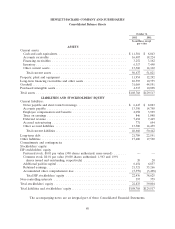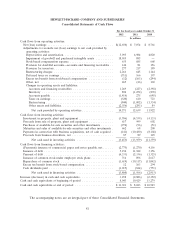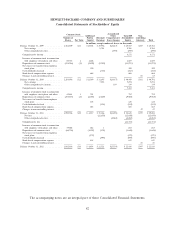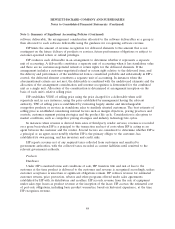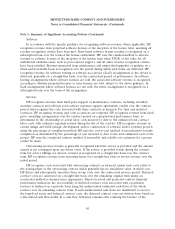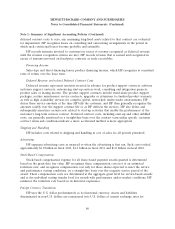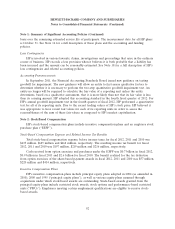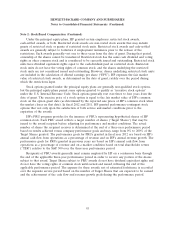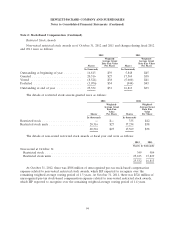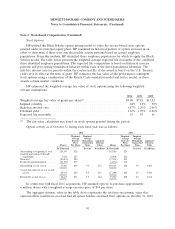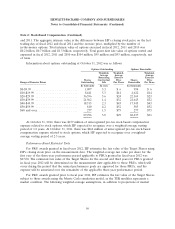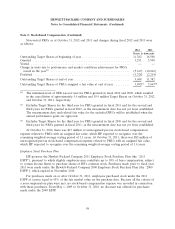HP 2012 Annual Report Download - page 98
Download and view the complete annual report
Please find page 98 of the 2012 HP annual report below. You can navigate through the pages in the report by either clicking on the pages listed below, or by using the keyword search tool below to find specific information within the annual report.HEWLETT-PACKARD COMPANY AND SUBSIDIARIES
Notes to Consolidated Financial Statements (Continued)
Note 1: Summary of Significant Accounting Policies (Continued)
Acquisition-related expenses and restructuring costs are recognized separately from the business
combination and are expensed as incurred.
Goodwill and Purchased Intangible Assets
Goodwill and purchased intangible assets with indefinite useful lives are not amortized but are
tested for impairment at least annually. HP reviews goodwill and purchased intangible assets with
indefinite lives for impairment annually at the beginning of its fourth fiscal quarter and whenever
events or changes in circumstances indicate the carrying value of an asset may not be recoverable. For
goodwill, HP performs a two-step impairment test. In the first step, HP compares the fair value of each
reporting unit to its carrying value. HP determines the fair values of its reporting units using a
weighting of fair values derived most significantly from the income approach and to a lesser extent the
market approach. Under the income approach, HP calculates the fair value of a reporting unit based
on the present value of estimated future cash flows. Cash flow projections are based on management’s
estimates of revenue growth rates and operating margins, taking into consideration industry and market
conditions. The discount rate used is based on the weighted-average cost of capital adjusted for the
relevant risk associated with business-specific characteristics and the uncertainty related to the
business’s ability to execute on the projected cash flows. Under the market approach, HP estimates the
fair value based on market multiples of revenue and earnings derived from comparable publicly-traded
companies with similar operating and investment characteristics as the reporting unit. The weighting of
the fair value derived from the market approach ranges from 0% to 50% depending on the level of
comparability of these publicly-traded companies to the reporting unit. When market comparables are
not meaningful or not available, HP may estimate the fair value of a reporting unit using only the
income approach. In order to assess the reasonableness of the calculated fair values of its reporting
units, HP also compares the sum of the reporting units’ fair values to HP’s market capitalization and
calculates an implied control premium (the excess of the sum of the reporting units’ fair values over
the market capitalization). HP evaluates the control premium by comparing it to control premiums of
recent comparable transactions. If the implied control premium is not reasonable in light of these
recent transactions, HP will reevaluate its fair value estimates of the reporting units by adjusting the
discount rates and/or other assumptions. As a result, when there is a significant decline in HP’s stock
price, as occurred during fiscal 2012, this reevaluation could correlate to lower estimated fair values for
certain or all of HP’s reporting units. If the fair value of the reporting unit exceeds the carrying value
of the net assets assigned to that unit, goodwill is not impaired, and no further testing is required. If
the fair value of the reporting unit is less than the carrying value, HP must perform the second step of
the impairment test to measure the amount of impairment loss, if any. In the second step, the reporting
unit’s fair value is allocated to all of the assets and liabilities of the reporting unit, including any
unrecognized intangible assets, in a hypothetical analysis that calculates the implied fair value of
goodwill in the same manner as if the reporting unit was being acquired in a business combination. If
the implied fair value of the reporting unit’s goodwill is less than the carrying value, the difference is
recorded as an impairment loss.
Except for Services, Software and Corporate Investments, HP’s reporting units are consistent with
the reportable segments identified in Note 19. The enterprise services (‘‘ES’’) and technology services
(‘‘TS’’) businesses are the reporting units within the Services segment. ES includes the Infrastructure
Technology Outsourcing (‘‘ITO’’) and Application and Business Services (‘‘ABS’’) business units. The
Software segment includes two reporting units, which are Autonomy Corporation plc (‘‘Autonomy’’) and
90


